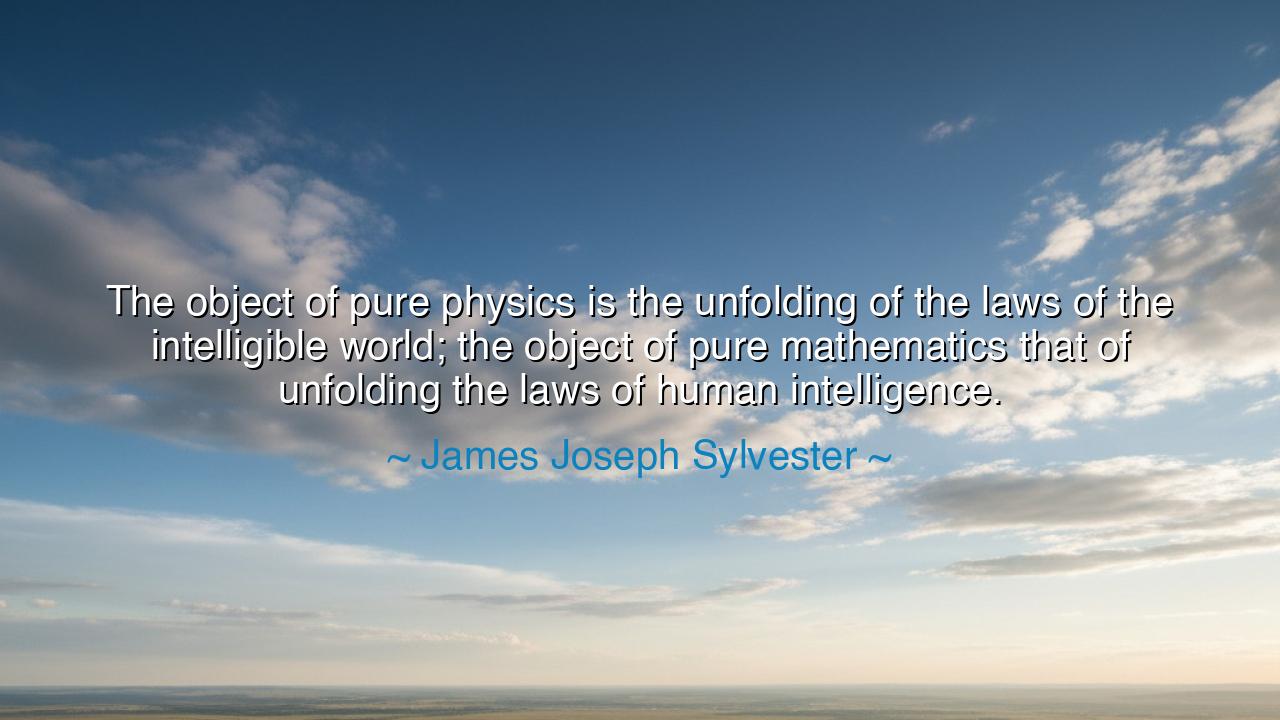
The object of pure physics is the unfolding of the laws of the
The object of pure physics is the unfolding of the laws of the intelligible world; the object of pure mathematics that of unfolding the laws of human intelligence.






James Joseph Sylvester offers a profound insight into the nature of pure physics and pure mathematics when he says, "The object of pure physics is the unfolding of the laws of the intelligible world; the object of pure mathematics that of unfolding the laws of human intelligence." In these words, Sylvester paints a picture of two intertwined yet distinct realms of knowledge. Physics, in its purest form, seeks to understand the laws that govern the physical universe, the forces that shape the cosmos, from the smallest particle to the vast expanse of the stars. On the other hand, mathematics is a language, a tool that allows us to unlock the deeper workings of the human mind itself, tracing the boundaries of our intellectual capacity and understanding.
The ancients recognized the profound relationship between the universe and the mind. The Greeks, led by figures like Pythagoras, Plato, and Aristotle, sought to understand the very essence of reality. For Pythagoras, the universe was governed by mathematical principles, and through mathematics, one could understand the cosmic order. This belief in the interconnection between mathematics and the natural world suggests that, as Sylvester implies, the study of physics is not merely about the material world but also an extension of the human mind’s quest to understand the laws of nature. When we unravel the laws of physics, we are, in essence, also engaging in an act of human intelligence—a reflection of our deepest intellectual pursuits.
Consider the journey of Isaac Newton, whose discoveries in physics—from the laws of motion to the theory of gravity—reshaped our understanding of the natural world. Yet, it was not purely empirical observation that drove him; it was his use of mathematical concepts to express and make sense of the intelligible world. Newton understood that mathematics was the bridge that connected human intelligence with the universe's truths. His work exemplifies Sylvester’s insight: mathematics is not merely a tool of calculation but a way of uncovering the laws of nature, of unlocking the mysteries of the universe.
In the same way, the greatest minds throughout history have understood that mathematics is not just about numbers; it is about the way our minds perceive and organize the world around us. Euclid, the ancient Greek mathematician, showed how mathematics could reveal the underlying structure of the universe through his work in geometry. Similarly, Albert Einstein, in his development of the theory of relativity, used mathematical principles to explain the very fabric of space-time. The connection between physics and mathematics is a deep one, for the study of the natural world cannot be separated from the study of human cognition. Mathematics allows us to translate our understanding of the world into a language that can be universally shared and understood.
The lesson to be learned from Sylvester’s words is one of profound unity: that the pursuit of knowledge, whether through physics or mathematics, is the pursuit of understanding itself. Physics teaches us the laws of the universe, revealing the beauty of nature’s intricate design. Yet mathematics, in its purest form, unveils the power of the human mind to interpret and make sense of that world. It is through mathematics that we learn to structure our thoughts, to find patterns in the chaos of existence, and to draw connections between the most abstract ideas and the most tangible realities. The study of both physics and mathematics is an exploration of the outer and inner worlds—of the universe we live in and the mind that seeks to understand it.
In practical terms, Sylvester’s philosophy calls us to recognize the interconnection between intellectual growth and the world around us. To pursue mathematics is to sharpen the mind, to refine our understanding of the universe and of ourselves. To pursue physics is to engage with the world in its most fundamental form, to learn not just about what is visible but also about the unseen forces that govern our lives. The true beauty lies in the union of these two pursuits: they are not separate but complementary, each feeding into the other, shaping our comprehension of the world and our place in it.
Thus, let us take this wisdom into our own lives. Let us approach mathematics not just as a tool for calculation but as a key to unlocking the deeper truths of our world. Let us look to physics not just as a study of matter but as a way of understanding the very laws of nature that govern our existence. And as we do, let us remember that in the pursuit of these disciplines, we are engaging in the eternal dance between the human mind and the intelligible world, ever striving to bring order, meaning, and understanding to the vastness of existence.






AAdministratorAdministrator
Welcome, honored guests. Please leave a comment, we will respond soon